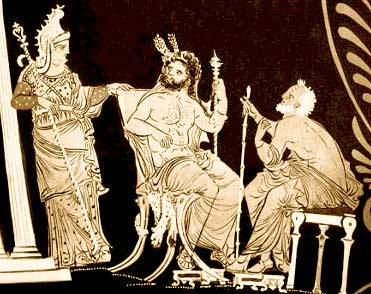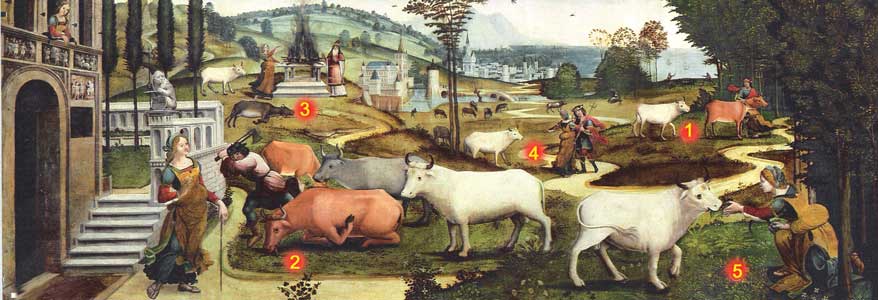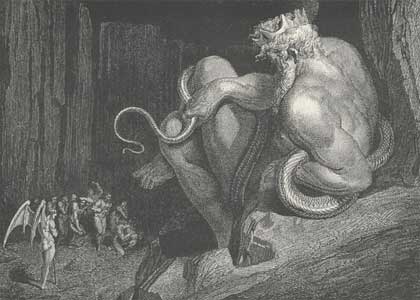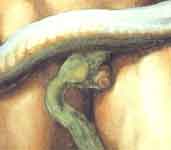.

Rhadamanthys Minos and Aeacus in the underworld
In Greek mythology, Minos was a semi-legendary king of Crete, son of Zeus and Europa. The Minoan civilization has been named after him. By his wife, Pasiphae, he was the father of Ariadne, Androgeus, Deucalion, Phaedra, Glaucus, Catreus . Acalle (or Acacallis acording to Pausanias 8.53.4) and many others.
With the Nymph Paria he was the father of
- Eurymedon, Nephalion, Chryses, Philoaus
With Dexithea he was the father of
- Euxanthius
Minos, along with his brothers, Rhadamanthys and Sarpedon, was raised by King Asterion (or Asterius) of Crete. When Asterion died, he gave his throne to Minos, who banished Sarpedon and (according to some sources) Rhadamanthys too.
It is not clear if Minos is a name or if it was the Cretan word for "King". Scholars have noted the interesting similarity between Minos and the names of other ancient founder-kings, such as Menes of Egypt, Mannus of Germany, Manu of India, and so on.
The Underworld. Minos Aiakos And Rhadamanthys
The historical and scholarly Minos
He reigned over Crete and the islands of the Aegean Sea three generations before the Trojan War. He lived at Knossos for periods of nine years, at the end of which he retired into a sacred cave, where he received instruction from Zeus in the legislation which he gave to the island. He was the author of the Cretan constitution and the founder of its naval supremacy (Herodotus 3.122; Thucydides 1.4).
In Attic tradition and on the Athenian stage Minos is a cruel tyrant, the heartless exactor of the tribute of Athenian youths to feed the Minotaur. It seems possible that tribute children were actually exacted to take part in the gruesome shows of the Minoan bull-rings, of which we now have more than one illustration. To reconcile the contradictory aspects of his character, two kings of the name of Minos were assumed by later poets and mythologists.
Since Phoenician intercourse was in later times supposed to have played an important part in the development of Crete, Minos is sometimes called a Phoenician. There is no doubt that there is a considerable historical element in the legend; recent discoveries in Crete prove the existence of a civilization such as the legends imply, and render it probable that not only Athens, but Mycenae itself, was once subject to the kings of Knossus, of whom Minos was greatest. In view of the splendour and wide influence of Minoan Crete, the age generally known as "Mycenaean" has been given the name of "Minoan" by Dr. Arthur Evans as more properly descriptive.
Minos himself is said to have died at Camicus in Sicily, whither he had gone in pursuit of Daedalus, who had given Ariadne the clue by which she guided Theseus through the labyrinth. He was killed by the daughter of Cocalus, king of Agrigentum, who poured boiling water over him in the bath (Diodorus Siculus 4.79). Subsequently his remains were sent back to the Cretans, who placed them in a sarcophagus, on which was inscribed: "The tomb of Minos, the son of Zeus."
The earlier legend knows Minos as a beneficent ruler, legislator, and suppressor of piracy (Thucydides 1.4). His constitution was said to have formed the basis of that of Lycurgus (Pausanias 3. 2, 4). In accordance with this, after his death he became judge of the shades in the under-world (Odyssey, 9.568); later he was associated with Aeacus and Rhadamanthus.
The solar explanation of Minos as the sun-god has been thrown into the background by the recent discoveries. In any case a divine origin would naturally be claimed for him as a priest-king, and a divine atmosphere hangs about him. The name of his wife, Pasiphae ("the all-shining"), is an epithet of the moon-goddess. The name Minos seems to be philologically the equivalent of Minyas, the royal ancestor of the Minyans of Orchomenus, and his daughter Ariadne ("the exceeding holy") is a double of the native nature-goddess.
Minos in art
On Cretan coins Minos is represented as bearded, wearing a diadem, curly-haired, haughty and dignified, like the traditional portraits of his reputed father, Zeus. On painted vases and sarcophagus bas-reliefs he frequently occurs with Aeacus and Rhadamanthus as judges of the under-world and in connection with the Minotaur and Theseus.
The mythological Minos
Miletus
Asterion, king of Crete, adopted the three sons of Zeus and Europa, Minos, Sarpedon and Rhadamanthus. In adulthood, the three brothers quarreled over a beautiful boy they were all in love with, by the name of Miletus (mythology), son of Apollo and Areia. The youth however preferred Sarpedon, so Minos in revenge went to war and conquered the whole island. Sarpedon and his boyfriend escaped to Lycia, where Miletus founded the city that bore his name. Other mythographers claimed that the beloved youth's name was Atymnios, and that he was the son of Zeus and Cassiopeia.(Apollodorus III.1.2)
Bernard Sergent claims that the story is a late invention in that the theme of competition for a beloved youth is not in keeping with the Cretan pederastic tradition, and there is no record of this Miletus prior to the second century BCE.
One day, Glaucus was playing with a ball or mouse and suddenly disappeared. His parents went to the oracle at Delphi who told them "A marvelous creature has been born amongst you: whoever finds the true likeness for this creature will also find the child."
They interpreted this to refer to a newborn calf in Minos' herd. Three times a day, the calf changed color from white to red to black. Polyidus observed the similarity to the ripening of the fruit of the blackberry plant and Minos sent him to search for Glaucus.
Searching for Glaucus, Polyidus saw an owl driving bees away from a wine-cellar in Minos' palace. Inside the wine-cellar was a cask of honey, with Glaucus dead inside. Minos demanded Glaucus be brought back to life, though Polyidus objected. As Minos hugged his son's corpse, a snake appeared nearby; Polyidus killed it with Minos' sword. Another snake came for the first, and after seeing the dead snake, the second serpent left and brought back an herb which then brought the first snake back to life. Following this example, Polyidus used the same herb to resurrect Glaucus.
Minos refused to let Polyidus leave Crete until he taught Glaucus everything he knew. Polyidus did so, but then, at the last second before leaving, he asked Glaucus to spit in his mouth. Glaucus did so, giving Polyidus back everything he had been taught.
Poseidon, Daedalus and Pasiphae

The History of the Minotaur from Cassone Paintings,16th century.
1) King Minos of Crete is assumed to sacrifice a white Bull sent by Poseidon. 2) Minos thinks that it is better to sacrifice another bull which is killed and 3) sacrificed. The punishment 4, 5 ): Poseidon caused Minos's wife Pasiphae to fell in love with the bull. The result was her son Minotaur.
Minos was challenged as king and prayed to Poseidon for help. Poseidon sent a giant white bull out of the sea. Minos planned on sacrificing the bull to Poseidon, but then decided not to. He substituted a different bull. In rage, Poseidon cursed Pasiphae, Minos' wife, with zoophilia. Daedalus built her a wooden cow, which she hid inside. The bull mated with the wooden cow and Pasiphae was impregnated by the bull, giving birth to a horrible monster, the Minotaur. Daedalus then built a complicated maze called the Labyrinth and Minos put the Minotaur in it. To make sure no one would ever know the secret of the Labyrinth, Minos imprisoned Daedalus and his son, Icarus, in a tower.
Daedalus and Icarus flew away on wings Daedalus invented, but Icarus' wings melted because he flew too close to the sun. Icarus fell in the sea and drowned.
Theseus
Some time later, Minos' son, Androgeus, lost every game in a contest to Aegeas of Athens. Alternatively, the other contestants were jealous of Androgeus and killed him. Minos was angry and declared war on Athens. He offered the Athenians peace if, every year, they sent him seven young men and seven young women to feed to the Minotaur. This continued until Theseus killed the Minotaur with the help of Ariadne, Minos' daughter.
Nisus
Minos was also part of the King Nisus story. Nisus was King of Megara, and he was invincible as long as a lock of red hair still existed, hidden in his white hair. Minos attacked Megara but Nisus knew he could not be beaten because he still had his lock of red hair. His daughter, Scylla, fell in love with Minos and proved it by cutting the red hair off her father's head. Nisus died and Megara fell to Crete. Minos killed Scylla for disobeying her father. She was changed into a seabird, relentlessly pursued by her father, who was a sea eagle.
The death of Minos
Minos searched for Daedalus by travelling from city to city asking a riddle. He presented a spiral seashell and asked for it to be strung all the way through. When he reached Camicus, Sicily, King Cocalus, knowing Daedalus would be able to solve the riddle, fetched the old man. He tied the string to an ant, which walked through the seashell, stringing it all the way through. Minos then knew Daedalus was in the court of King Cocalus and demanded he be handed over. Cocalus managed to convince him to take a bath first. Cocalus' daughters then killed Minos by burning him with boiling water.
After his death, Minos became a judge of the dead in Hades together with Aeacus and Radamanthus. Rhadamanthus judged the souls of Asians, Aeacus judged Europeans and Minos had the deciding vote.
In poetry
In the Aeneid of Virgil, Minos was the judge of those who had been given the death penalty on a false charge - Minos sits with a gigantic urn, and decides whether a soul should go to Elysium or Tartarus with the help of a silent jury. Radamanthus, his brother, is a judge at Tartarus who decides upon suitable punishments for sinners there (Aeneid VI, 568– -572).

Minos in Hades, "There, Minos stands
Grinning with ghastly feature: he, of all
Who enter, strict examining the crimes",
Dante, The Vision of Hell
Gustave Dore, "There Minos Stands"
In Dante's The Divine Comedy, Minos sits at the entrance to the second circle in the Inferno, which is the beginning of proper Hell. Here, he judges the sins of each soul and assigns it to its rightful punishment by indicating the circle to which it must descend. He does this by circling his tail around his body the appropriate number of times. He can also speak, to clarify the soul's location within the circle indicated by the wrapping of his tail (Inferno V, 4–24; XXVII, 124–127).


Minos by Michelangelo in the Vatican, a snake bites a very sensitive part of the Cretan king
The Story of Pasiphae, Theseus and the Minotaur
| The Greek Underworld | |
|---|---|
| Residents: | |
| Geography: | |
|
|
| Famous inmates: | |
See also : Greek Mythology. Paintings, Drawings
| Ancient Greece
Science, Technology , Medicine , Warfare, , Biographies , Life , Cities/Places/Maps , Arts , Literature , Philosophy ,Olympics, Mythology , History , Images Medieval Greece / Byzantine Empire Science, Technology, Arts, , Warfare , Literature, Biographies, Icons, History Modern Greece Cities, Islands, Regions, Fauna/Flora ,Biographies , History , Warfare, Science/Technology, Literature, Music , Arts , Film/Actors , Sport , Fashion --- |
Retrieved from "http://en.wikipedia.org"
All text is available under the terms of the GNU Free Documentation License


